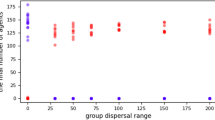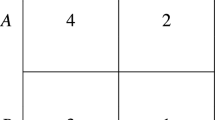Abstract
THE 'iterated prisoner's dilemma' is now the orthodox paradigm for the evolution of cooperation among selfish individuals. This viewpoint is strongly supported by Axelrod's computer tournaments, where 'tit for tat' (TFT) finished first1. This has stimulated interest in the role of reciprocity in biological societies1–8. Most theoretical investigations, however, assumed homogeneous populations (the setting for evolutionary stable strategies9,10) and programs immune to errors. Here we try to come closer to the biological situation by following a program6 that takes stochasticities into account and investigates representative samples. We find that a small fraction of TFT players is essential for the emergence of reciprocation in a heterogeneous population, but only paves the way for a more generous strategy. TFT is the pivot, rather than the aim, of an evolution towards cooperation.
This is a preview of subscription content, access via your institution
Access options
Subscribe to this journal
Receive 51 print issues and online access
$199.00 per year
only $3.90 per issue
Buy this article
- Purchase on Springer Link
- Instant access to full article PDF
Prices may be subject to local taxes which are calculated during checkout
Similar content being viewed by others
References
Axelrod, R. The Evolution of Cooperation (Basic Books, New York, 1984).
Axelrod, R. & Hamilton, W. D. Science 211, 1390–1396 (1981).
Trivers, R. Social Evolution (Cummings, Menlo Park, 1985).
Axelrod, R. & Dion, D. Science 242, 1385–1390 (1988).
Boyd, R. & Lorberbaum, J. P. Nature 327, 58–59 (1987).
May, R. M. Nature 327, 15–17 (1987).
Milinski, M. Nature 325, 434–435 (1987).
Wilkinson, G. S. Nature 308, 181–184 (1984).
Maynard Smith, J. Evolution and the Theory of Games (Cambridge University Press, UK, 1982).
Hofbauer, J. & Sigmund, K. The Theory of Evolution and Dynamical Systems (Cambridge University Press, UK, 1988).
Axelrod, R. in Genetic Algorithms and Simulated Annealing (ed. Davis, D.) (Pitman, London, 1987).
Selten, R. Internat. J. Game Th. 4, 25–55 (1975).
Boyd, R. J. theor. Biol. 136, 47–56 (1989).
Nowak, M. & Sigmund, K. J. theor. Biol. 137, 21–26 (1989).
Nowak, M. & Sigmund, K. Acta appl. Math. 20, 247–265 (1990).
Nowak, M. Theor. Pop. Biol. 38, 93–112 (1990).
Molander, P. J. Conflict Resolut. 29, 611–618 (1985).
Lindgren, K. in Artificial Life II (eds Farmer, D. et al.) (Proc. Santa Fe Inst. Stud., Addison-Welsey 1991).
Author information
Authors and Affiliations
Rights and permissions
About this article
Cite this article
Nowak, M., Sigmund, K. Tit for tat in heterogeneous populations. Nature 355, 250–253 (1992). https://doi.org/10.1038/355250a0
Received:
Accepted:
Issue Date:
DOI: https://doi.org/10.1038/355250a0
This article is cited by
-
Effect of reciprocity mechanisms on evolutionary dynamics in feedback-evolving games
Nonlinear Dynamics (2024)
-
Sustaining medical research – the role of trust and control
Health Economics Review (2023)
-
The effect of environmental information on evolution of cooperation in stochastic games
Nature Communications (2023)
-
Influence theory
Synthese (2023)
-
Evolution of cooperation through cumulative reciprocity
Nature Computational Science (2022)
Comments
By submitting a comment you agree to abide by our Terms and Community Guidelines. If you find something abusive or that does not comply with our terms or guidelines please flag it as inappropriate.



